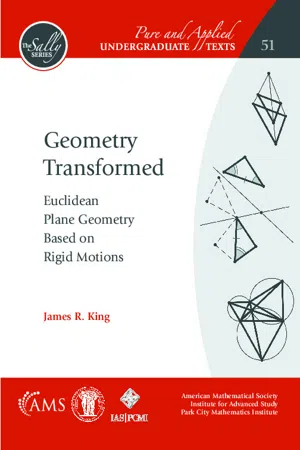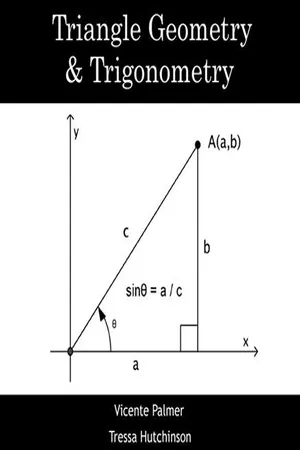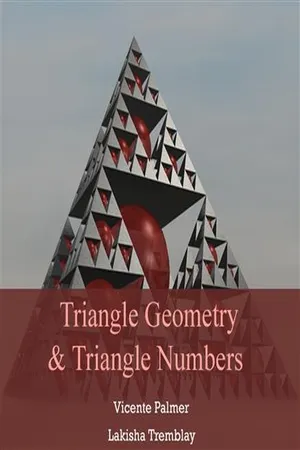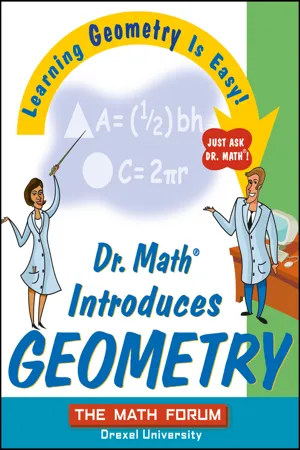Mathematics
Area of Triangles
The area of a triangle is the measure of the space enclosed by the three sides of the triangle. It is calculated using the formula A = 1/2 * base * height, where A represents the area, and the base and height are the respective measurements of the triangle. Understanding the concept of area is fundamental in geometry and practical applications involving shapes.
Written by Perlego with AI-assistance
Related key terms
1 of 5
11 Key excerpts on "Area of Triangles"
- eBook - PDF
- Alberto D. Yazon(Author)
- 2019(Publication Date)
- Society Publishing(Publisher)
Perimeter and Area 87 Equilateral Triangle Isosceles Triangle Scalene Triangle P = 3 * I P = 2*I + b P = a + b + c where a, b, c, and l are the side lengths and P = perimeter. A right triangle has a base (b), hypotenuse (h) and perpendicular (p) as its sides, with the help of the Pythagoras theorem, we know: h 2 = b 2 + p 2 In this way, the perimeter of a right angle triangle = b + p + h 4.7.3. Area of Triangle The area of a triangle is explained as the total space that is surrounded with the help of any particular type of triangle. The basic formula is used to evaluate the area of a given triangle is A = 1/2 × b × h, where b denotes the base and h denotes the height of the given triangle, whether it is a scalene triangle, isosceles triangle or equilateral triangle (Figure 4.14). Figure 4.14: Block diagram of an area of a triangle. Source: https://upload.wikimedia.org/wikipedia/commons/thumb/0/01/ Moment_of_area_of_a_triangle_through_the_base_with_%27a%27_di-mension.svg/2000px-Moment_of_area_of_a_triangle_through_the_base_ with_%27a%27_dimension.svg.png. Introduction to Mathematical Literacy 88 Examples: To determine the area of the triangle with base b as 3 cm and height has 4 cm, then the formula will be used for: Area of a Triangle (A) = 1/2 × b × h = 1/2 × 4 cm × 3 cm = 2 cm × 3 cm = 6 cm 2 Generally, the term “area of a triangle” is explained as the area which is occupied inside the boundary of a flat object or figure. The evaluation at its initial stage took place in square units with the standard unit being square meters (m 2 ). For the evaluation of the area, there are pre-defined formulas for squares, rectangles, circle, triangles, etc. The area of the triangle is given with the help of the formula which is mentioned below: Area of a triangle = A = ½ (b × h) square units where a, b, and c are the three sides of a triangle. - eBook - PDF
- (Author)
- 2015(Publication Date)
- For Dummies(Publisher)
322 Part IV: Applying Algebra and Understanding Geometry Tuning in triangles Finding the area of a triangle can be a bit of a challenge. Basically, a triangle’s area is half that of an imaginary rectangle that the triangle fits into. However, it isn’t always easy or necessary to find the length and width of this hypothetical rectangle — you just need a measurement or two from the triangle. The traditional formula for finding the area of a triangle involves the length of the base, or bottom, and the height, the perpendicular distance from the base up to the vertex (the intersection of the other two sides). Finding the area of a triangle is easy if you can use a ruler to find the height, but that isn’t always practical. So, you have another option — Heron’s formula, covered later in this section. Going the traditional route The area of a triangle is equal to half the product of the measure of the base of the triangle, b, times the height of the triangle, h: A bh 1 2 = . The base is the length of the bottom that the height is drawn down to. The height is the length from the top angle down perpendicular to the base. The height forms a right angle (90 degrees) with the base. Figure 15‐4 shows you a triangle with a height drawn. You use this traditional rule for area when it’s possible to make these measurements — when you can draw the height perpendicular to the base and measure both of them. The following example shows you how to use the best‐known rule first, and a later example finds the same area using Heron’s formula. Find the area of a triangle 21 metres long with a height of 8 metres. Refer to Figure 15‐4 for a sketch of such a triangle. Figure 15-4: Triangles come in all shapes and sizes. - eBook - PDF
Geometry Transformed
Euclidean Plane Geometry Based on Rigid Motions
- James R. King(Author)
- 2021(Publication Date)
- American Mathematical Society(Publisher)
Chapter 9 Area and Its Applications Areas of Triangles and Parallelograms Area, a familiar and useful topic in the real world, is not only an interesting topic in geometry; it also provides an additional tool for understanding geometrical relation-ships. While it is simple in some respects, it is not so simple in others. The simple part includes the familiar formulas for areas of rectangles, triangles, parallelograms, and other basic polygons. The not-so-simple part is expressing a general definition of area and then proving it agrees with the simple formulas but also applies to shapes such as circles and other nonpolygonal shapes. To derive an area formula for circles, limits are involved. This is as far as we will be going in this book. 1 Area should have these properties: • Congruent figures have the same area. • For a square ? of side length 1, the area 𝒜(?) = 1 . • If the set ? 1 contains ? 2 , then 𝒜(? 1 ) ≥ 𝒜(? 2 ) . • If a set ? is the union of a finite number ? 1 , ? 2 , ... , ? 𝑘 of convex polygons and their interiors such that the polygon interiors do not intersect, then 𝒜(?) = 𝒜(? 1 ) + 𝒜(? 2 ) + ⋯ + 𝒜(? 𝑘 ). Squares and the Definition of Area. All our work with area will rely on the areas of squares. Consider how only one definition makes sense. A square of integer side 𝑚 can be divided into 𝑚 2 unit squares of side 1, so the area should be 𝑚 2 . For example, the square on the left of Figure 1 is 9, assuming the small squares have side 1. If the area of a square of side 1 is divided into squares of side length 1/𝑛 , then since there are 𝑛 2 such small squares, the area of the small square should be 1/𝑛 2 . The area of 1 If one investigates really complicated sets in the plane, such as fractals, it turns out that a set may have no area, or it may have more than one value competing to be area. 161 - No longer available |Learn more
- (Author)
- 2014(Publication Date)
- Library Press(Publisher)
The term 'base' denotes any side, and 'height' denotes the length of a perpen-dicular from the vertex opposite the side onto the line containing the side itself. In 499 CE Aryabhata, a great mathematician-astronomer from the classical age of Indian mathematics and Indian astronomy, used this method in the Aryabhatiya (section 2.6) . Although simple, this formula is only useful if the height can be readily found. For example, the surveyor of a triangular field measures the length of each side, and can find the area from his results without having to construct a 'height'. Various methods may be used in practice, depending on what is known about the triangle. The following is a selection of frequently used formulae for the area of a triangle. Using vectors The area of a parallelogram embedded in a three-dimensional Euclidean space can be calculated using vectors. Let vectors AB and AC point respectively from A to B and from A to C. The area of parallelogram ABDC is then which is the magnitude of the cross product of vectors AB and AC . The area of triangle ABC is half of this, . ________________________ WORLD TECHNOLOGIES ________________________ The area of triangle ABC can also be expressed in terms of dot products as follows: In two-dimensional Euclidean space, expressing vector AB as a free vector in Cartesian space equal to ( x 1 , y 1 ) and AC as ( x 2 , y 2 ), this can be rewritten as: Applying trigonometry to find the altitude h Using trigonometry The height of a triangle can be found through the application of trigonometry. Knowing SAS : Using the labels in the image on the left, the altitude is h = a sin γ . Sub-stituting this in the formula Area = ½ bh derived above, the area of the triangle can be expressed as: (where α is the interior angle at A, β is the interior angle at B, γ is the interior angle at C and c is the line AB). Furthermore, since sin α = sin ( π - α) = sin (β + γ), and similarly for the other two angles: Knowing AAS : - No longer available |Learn more
- (Author)
- 2014(Publication Date)
- Library Press(Publisher)
The term 'base' denotes any side, and 'height' denotes the length of a perp-endicular from the vertex opposite the side onto the line containing the side itself. In 499 CE Aryabhata, a great mathematician-astronomer from the classical age of Indian mathematics and Indian astronomy, used this method in the Aryabhatiya (section 2.6) . Although simple, this formula is only useful if the height can be readily found. For example, the surveyor of a triangular field measures the length of each side, and can find the area from his results without having to construct a 'height'. Various methods may be used in practice, depending on what is known about the triangle. The following is a selection of frequently used formulae for the area of a triangle. Using vectors The area of a parallelogram embedded in a three-dimensional Euclidean space can be calculated using vectors. Let vectors AB and AC point respectively from A to B and from A to C. The area of parallelogram ABDC is then which is the magnitude of the cross product of vectors AB and AC . The area of triangle ABC is half of this, . ________________________ WORLD TECHNOLOGIES ________________________ The area of triangle ABC can also be expressed in terms of dot products as follows: In two-dimensional Euclidean space, expressing vector AB as a free vector in Cartesian space equal to ( x 1 , y 1 ) and AC as ( x 2 , y 2 ), this can be rewritten as: Applying trigonometry to find the altitude h Using trigonometry The height of a triangle can be found through the application of trigonometry. Knowing SAS : Using the labels in the image on the left, the altitude is h = a sin γ . Sub-stituting this in the formula Area = ½ bh derived above, the area of the triangle can be expressed as: (where α is the interior angle at A, β is the interior angle at B, γ is the interior angle at C and c is the line AB). Furthermore, since sin α = sin ( π - α) = sin (β + γ), and similarly for the other two angles: Knowing AAS : - eBook - PDF
Mathematics for Elementary Teachers
A Contemporary Approach
- Gary L. Musser, Blake E. Peterson, William F. Burger(Authors)
- 2013(Publication Date)
- Wiley(Publisher)
D A B C 7 E 6 4 6 Figure 13.40 The area of the parallelogram is 6 4 24 ¥ = and the area of the triangle is 1 2 7 4 14 ¥ = for a total area of 38 square units. If the equation for the area of a trapezoid is used, the computation would be 1 2 6 13 4 2 19 38 ( ) + = = ¥ ¥ square units. ■ O A s B r Figure 13.41 Section 13.2 Length and Area 673 A rigorous verification of this formula cannot be done without calculus-level mathematics. However, areas of irregular two-dimensional regions can be approxi- mated by covering the region with a grid. Area of a Circle The area A of a circle with radius r is A r = p 2 . r Common Core – Grade 7 Know the formulas for the area and circumference of a circle and use them to solve problems; give an informal derivation of the relationship between the circumference and area of a circle. T H E O R E M 1 3 . 5 The dimensions of the “key” on a standard basketball court are shown in Figure 13.42 where the curve at the right is a semicircle. If you were given the task to paint the key prior to the lines being painted, how many square feet of area do you need to cover. 19 ft 12 ft Figure 13.42 SOLUTION This basketball key can be broken into a rectangle and a semicircle as shown in Figure 13.43. 19 ft 12 ft 6 ft Figure 13.43 The area of the rectangle is 12 19 228 2 ¥ = ft and the area of the semicircle is 1 2 2 6 18 56 5 2 p p ¥ ¥ = ≈ . ft for a total area of 284 5 2 . ft . ■ 674 Chapter 13 Measurement The Pythagorean Theorem The Pythagorean theorem, perhaps the most spectacular result in geometry, relates the lengths of the sides in a right triangle; the longest side is called the hypotenuse and the other two sides are called legs. Figure 13.44 shows a special instance of the Pythagorean theorem in an arrangement involving isosceles right triangles. - eBook - PDF
- Tom Bassarear, Meg Moss(Authors)
- 2019(Publication Date)
- Cengage Learning EMEA(Publisher)
A key aspect here is that the base and the height are perpendicular (they form a right angle). Figure 9.10 base height base height B. Understanding the area formula for triangles Consider triangle MAN (Figure 9.11). If we make a congruent copy of this triangle and move that triangle into place as shown (that is, by rotating it 180 degrees), we form a parallelogram. M Y A N M A N base base height height Figure 9.11 Section 9.2 Perimeter and Area 537 The base of the parallelogram and the base of the triangle are identical, and so are their heights. The area of a triangle is 1 2 of the area of the whole parallelogram. So, area of triangle 5 (area of parallelogram) (base)(height) 1 2 1 2 5 . In other words, the formula we just found for the area of a triangle is A bh 1 2 5 . C. Understanding the area formula for trapezoids We will consider two ways to find this. One way is to draw a diagonal of the trapezoid, which cuts it into two triangles (Figure 9.12). We know how to find the areas of these triangles: The areas are 1 2 ah and 1 2 bh. The sum of the areas of the two triangles is equal to the area of the trapezoid, so the area A of the trapezoid is 1 2 1 2 ah bh 1 or, if we factor out the 1 2 and the h, we get A a b h ( ) 1 2 5 1 (Figure 9.13). a h b a h b Figure 9.12 Figure 9.13 Figure 9.14 shows another method for finding the area of a trapezoid. If we construct a congruent trapezoid and connect it to the original trapezoid, we have a parallelogram, and the area of the parallelogram is equal to the product of its base and its height; The base of this paral- lelogram is a b ( ) 1 , so the area of the parallelogram is a b h ( ) 1 . Because the area of the trapezoid is equal to one-half the area of this parallelogram, the area of the trapezoid ( ) 1 2 a b h 5 1 . Figure 9.14 a h a 1 b b b a INVESTIGATION 9.2d Converting Units of Area Converting area units is different than converting linear units, and thus an investigation will help you to own this idea. - eBook - PDF
Dr. Math Introduces Geometry
Learning Geometry is Easy! Just ask Dr. Math!
- (Author)
- 2004(Publication Date)
- Jossey-Bass(Publisher)
And we have two of these triangles, so the total area of this trapezoid is the area of the rectangle plus the areas of the two triangles, or 15 + 3 + 3 = 21. If I were going to make a generic formula for an isosceles trape- zoid, I’d do it this way: So, for example: If you check my work here and plug in AE = 3, AB = 5, and DC = 9, do you still get 21? —Dr. Math, The Math Forum Areas and Perimeters of Two-Dimensional (2-D) Geometric Figures 81 area rectangle + triangle + triangle area base height 1 2 base height 1 2 base height 1 2 = = ⋅ + ⋅ + ⋅ area area area area area = ⋅ + − ⋅ + − ⋅ = ⋅ + − ⋅ = ⋅ + − = ⋅ + − ⋅ = ⋅ ⋅ + ⋅ AB AE DC AB AE DC AB AE AB AE DC AB AE AE AB DC AB AE AB DC AB AE AB DC 1 2 1 2 1 2 1 2 1 2 1 2 1 2 1 2 1 2 1 2 ( ) ( ) ( ) ( ) = ⋅ ⋅ + area 1 2 AE AB DC ( ) 82 Dr. Math Introduces Geometry Dear Dr. Math, We were told that the area of a trapezoid is half the sum of the parallel sides multiplied by the height. How can I visually prove this formula? I know that with a parallelogram you can cut off the triangle piece at one end, attach it at the other end, and you have a rectangle again, so that proves why the formula area = base ⋅ height works. Is there a similar way to prove why the trapezoid formula works? Yours truly, Lorraine Trapezoids: Visual Proof of the Area Formula Dear Lorraine, Consider this trapezoid, with bases of a and b and a height of h: If we connect the midpoints of the legs of the trapezoid, we get a seg- ment that has a length that’s exactly between the length of the top (a) and the bottom (b)—it’s the average of the other two lengths. So its length is a + b — 2 . We can also construct perpendicular lines from those midpoints to the bottom to construct small right triangles, as in this figure: If we rotate those right triangles up around the midpoints until they hit the side of the trapezoid, we end up with a rectangle. - No longer available |Learn more
- Tom Bassarear, Meg Moss(Authors)
- 2015(Publication Date)
- Cengage Learning EMEA(Publisher)
All Rights Reserved. May not be copied, scanned, or duplicated, in whole or in part. Due to electronic rights, some third party content may be suppressed from the eBook and/or eChapter(s). Editorial review has deemed that any suppressed content does not materially affect the overall learning experience. Cengage Learning reserves the right to remove additional content at any time if subsequent rights restrictions require it. Unless otherwise noted, all content on this page is © Cengage Learning Section 9.2 Perimeter and Area 529 When we step back and consider, we can see that the height is the radius of the circle. If we look at the base, the length of the base is equivalent to the width of eight sectors, but eight sectors is equivalent to half of the total distance around the circle, or 1 2 of the circumference. Since the circumference is 2 r , then half the circumference is r . The next figure shows this. π r r Therefore, since to find the area of a parallelogram we multiply base 3 height, the area of the figure is A 5 ( r )( r ) 5 r 2 HISTORY We know that the Egyptians and the Babylonians knew not only the formulas for the area of the square and the rectangle, but also the formula for the area of a trapezoid. They knew the formula for finding the area of a right triangle. There were correct and incorrect formulas for the areas of isosceles triangles. For example, there is an example in the Rhind papyrus (from ancient Egypt) of finding the area of an isosceles triangle by finding half the product of the base and the length of one of the equal sides, instead of the altitude. For the circle, the Babylonians developed the formula A 5 C 2 12 and the Egyptians developed the formula A = ( 8 9 d ) 2 . It will be left as an exercise to see how close their formulas were to the actual formula. INVESTIGATION 9.2e A 16-Inch Pizza versus an 8-Inch Pizza Let’s say you are going out to have pizza with several friends. - eBook - PDF
- John Peterson, Robert Smith(Authors)
- 2019(Publication Date)
- Cengage Learning EMEA(Publisher)
A 5 1 2 bh where A 5 area b 5 base h 5 height Example Find the area of the triangle shown in Figure 60-2. A 5 1 2 s 22.0 mm d s 19.0 mm d A 5 209 mm 2 Ans AREAS OF TRIANGLES GIVEN THREE SIDES Often, three sides of a triangle are known, but a height is not known. A height can be de-termined by applying the Pythagorean theorem and a system of equations. However, with a calculator, it is quicker and easier to compute areas of triangles, given three sides using a formula called Hero’s (or Heron’s ) formula . Hero’s (Heron’s) Formula A 5 Ï s s s 2 a d s s 2 b d s s 2 c d where A 5 area a , b , and c 5 sides s 5 1 2 s a 1 b 1 c d Example Refer to the flat triangular brace shown in Figure 60-3. a. Find the area of the brace. b. Find the height JK . Solutions a. Compute the area by using Hero’s formula. s 5 1 2 s 7.84 in. 1 5.12 in. 1 10.20 in. d s 5 11.58 in. A 5 Ïs 11.58 in. d s 11.58 in. 2 7.84 in. d s 11.58 in. 2 5.12 in. d s 11.58 in. 2 10.20 in. d A 5 Ïs 11.58 in. d s 3.74 in. d s 6.46 in. d s 1.38 in. d A < Ï 386.093 in. 4 < 19.65 sq in. Ans D C A E B FIGURE 60-1 22.0 mm 1 9.0 mm FIGURE 60-2 7.84 in. K J 5.12 in. 10.20 in. FIGURE 60-3 UNIT 60 AREAS OF TRIANGLES 451 b. Compute height JK from the formula A 5 1 2 bh . 19.65 sq in. < 1 2 s 10.20 in. d s JK d 19.65 sq in. < s 5.10 in. d s JK d JK < 3.85 in . Ans APPLICATION Tooling Up 1. Find the area of this figure. Round your answer to 2 decimal places. 0.418 0 0.834 0 0.524 0 3.524 0 15 0 2. Three circles are equally spaced on a bolt circle 8.4 cm in diameter. Use construction techniques to lay out the centers for the holes. 3. The four holes in the figure are 0.8 cm in diameter and equally spaced around the bolt circle. Find the distances x and y rounded to 2 decimal places. 20 cm x y 452 SECTION 6 GEOMETRIC FIGURES: AREAS AND VOLUMES 4. Plans call for triangle △ BCD to be sheared off a corner of a rectangle as shown in the figure. A decision is made to move one vertex of the triangle 1.5 in. - eBook - PDF
Mathematical Literacy NQF4 SB
TVET FIRST
- K van Niekerk O Roberts(Author)
- 2017(Publication Date)
- Macmillan(Publisher)
79 Module 3 Solving space, shape and orientation problems a) Area = area of semi-circle + area of rectangle = 1 __ 2 π r 2 + (length × breadth) = 26,14 cm 2 Remember, the perimeter is the length around the shape, so do not count the flat side of the semi-circle. b) Perimeter = 1 __ 2 circumference + length of three sides of the rectangle = π r + 2 + 6 + 2 = 19,42 cm Example 3.3 Calculate: a) the perimeter of this shape. b) the area of the white part of this shape. 1,25 m 2,5 m 2,5 m 2,5 m Solution First write in all the information that you are given about the shape: a) Perimeter of the whole shape = three sides of the square + two sides of the triangle. First find the hypotenuse of the triangle, using Pythagoras. Hypotenuse 2 = 2,5 2 + 2,5 2 = 12,5 ∴ Hypotenuse = √ _____ 12,5 = 3,54 m Perimeter = 3(2,5) + 3,54 + 2,5 = 13,54 m b) The figure is made of a square with a triangle cut out of it, and a larger triangle. Area = (area of square – grey triangle) + white triangle = [(2,5) 2 – 1 __ 2 (1,25 × 2,5)] + 1 __ 2 (2,5)(2,5) = 6,25 – 1,5625 + 3,125 = 7,81 m 2 1,25 m 2,5 m 2,5 m 2,5 m 80 Module 3 Topic 2: Space, shape and orientation Changing the subject of a formula We can change a formula around to calculate a different quantity, without changing the facts in the formula. Follow these steps: l Write down the formula and any information you are given. l Change the formula so that the unknown value is on the left-hand side. l Put the known values into the formula and do the calculation. Example 3.4 1. In this triangle, calculate the length of the base. Base ? Area 30 cm 5 cm 2 2. The sides of a square are unknown but its area is 289 cm 2 . Using A = s 2 , calculate the length of each side. 3. A rectangular field has a fence that is 600 m long. If one of its sides is 180 m long, how long are the other sides? Solution 1. This is a right-angled triangle. The side that is 5 cm long is perpendicular to the base, so it is the perpendicular height.
Index pages curate the most relevant extracts from our library of academic textbooks. They’ve been created using an in-house natural language model (NLM), each adding context and meaning to key research topics.










